Note: Measurements taken in the anechoic chamber at Canada's National Research Council can be found through this link.
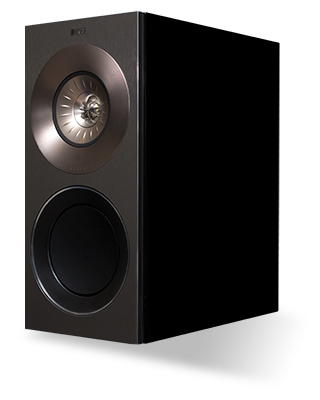
 “Whoa! Those speakers look cool!”
“Whoa! Those speakers look cool!”
How many hi-fi components earn that sort of remark from an audiophile’s spouse? But that’s what my wife said when she walked in, glanced at the newly arrived review samples of KEF’s Reference 1 loudspeaker -- and did a double take.
The 1 is part of the newest iteration of KEF’s Reference series, which was introduced at High End 2014, in Munich. It’s an important line for KEF that dates back to 1973 and the introduction of the classic Model 104. Priced above KEF’s R models and below the Blades, the newest Reference line comprises the sole stand-mounted model, the 1 ($7499.99 USD per pair); the floorstanding 3 ($12,999.99/pair) and 5 ($17,999.99/pair); the 2c ($4999.99) and the enormous 4c ($7499.99) center-channel models; and the 8b subwoofer ($5499.99).
And why wouldn’t my wife be so impressed with what she saw? One glance at the Reference 1 and you’ll see what looks like one of the most tricked-out, high-tech box speakers on the planet. But would the 1 sound as impressive as it looks?
Preamble
When I first saw the new Reference models in Munich, I was surprised that they were traditional rectangular boxes, mostly because the company’s pricier Blade and Blade Two models are shaped so . . . out there. What I learned was that the Reference-series speakers are more typically styled to appeal to those who want to have something that looks more like a classic loudspeaker in their living room, not a sculpture or an industrial-design statement.
But KEF’s decision to go traditional should have been a problem for me, because I like it when companies push the envelope with appearance, which is one of the reasons I liked the original Blade so much -- not to mention Vivid Audio’s Giya series. Nonetheless, the References still pushed my hot buttons -- as I said above, they look far more tricked out than most box speakers, and, combined with the technology employed, completely unlike anything else on the market.
Description
The Reference 1 isn’t really large, but at 17.2”H x 8”W x 15.25”D (excluding the connectors and grille), it’s bigger than most stand-mounted speakers. Its weight of 40 pounds isn’t outrageously heavy, but it isn’t light -- the speaker feels substantial. The top, bottom, side, and rear panels are made of MDF, braced inside, and clad in one of three exceptional-looking finishes. The review samples were in Deep Piano Black, which looked great, but at Munich I saw the Ref 1s in Luxury Gloss Rosewood and was bowled over by their gorgeous appearance. If I were to purchase a pair of 1s, that’s what I’d get. Satin American Walnut is also available.
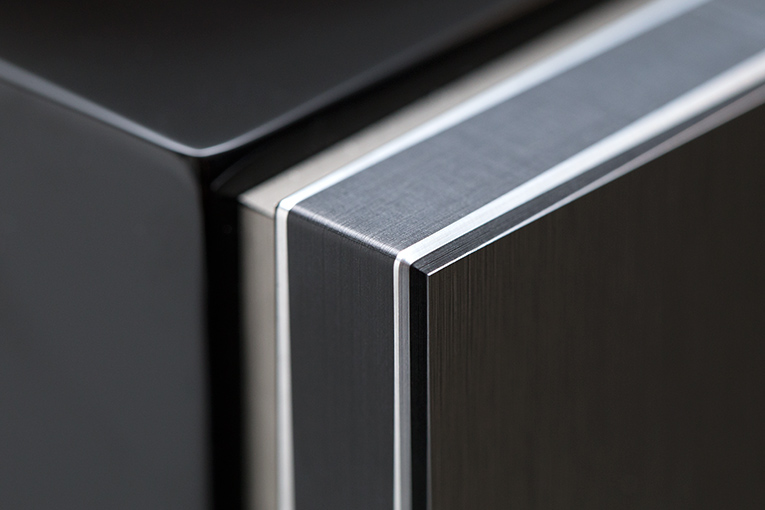
More interesting is the Ref 1’s front baffle, made of a composite of aluminum and resin and secured to the cabinet with “high-loss pads and high tensile bolts.” This combination of baffle materials is new for KEF, as are the bolts. The pads add damping, while the bolts, which run from the baffle all the way through to the rear panel, increase the structure’s rigidity -- all to reduce driver-induced cabinet resonances.
Toward the top of the baffle is the newest version of KEF’s Uni-Q driver array: a 1” aluminum-dome tweeter nestled into the center of an ideally shaped 5” aluminum cone for the midrange, a positioning that puts both drive units in the same acoustic space and allows for consistent dispersion from these drivers in all directions -- left, right, above, below, etc. In contrast, the radiation patterns of the separately positioned drivers found in most speaker designs differ in all directions -- not that big a problem for the bass and lower-midrange frequencies, whose wavelengths are so long, but an increasing problem as the frequencies rise. Surrounding the Uni-Q array is a silver-colored, slightly flared aluminum flange that conceals the driver bolts and, in tandem with the midrange’s flat surround, makes for a smooth acoustic transition from the tweeter and midrange to the baffle area and beyond, KEF claims.
Placing a tweeter in the throat of a cone driver isn’t unique to KEF -- the idea goes back decades, and several companies have their own versions. But KEF’s implementation of it in their Uni-Q models is probably the most advanced out there. First is the shape of the midrange cone and the unobtrusive surround, which combine to act as an ideal waveguide for the tweeter that is largely devoid of the deleterious diffraction effects of typical cones and surrounds. This cone-based waveguide not only helps control the tweeter’s dispersion, it provides considerable gain, which allows the tweeter to work less hard to produce higher output while generating significantly less heat and distortion. The waveguide begins to boost the tweeter’s gain at about 15kHz, this effect steadily growing as the frequency decreases, until about 4kHz, at which point it’s boosting output by about 8dB. After that, the waveguide’s ability to provide gain gradually decreases to zero, at about 500Hz. But at 2.8kHz, where the tweeter is crossed over to the midrange cone, the waveguide is still providing the tweeter with about 7.5dB of gain.
What the cone can’t do well, however, is control dispersion and provide gain for the frequencies nearer the top of the audioband. That’s where the “tangerine” waveguide (the quotation marks are KEF’s) comes in -- that nifty finned thing in front of the tweeter that’s the brainchild of one of KEF’s lead designers, Jack Oclee-Brown, who told me he’d developed it as part of his thesis work at the University of Southampton, in England. Unlike the midrange cone, which works from about 500Hz to 15kHz, the “tangerine” works from about 7kHz to beyond the audioband. Oclee-Brown told me that the “tangerine” helps control the tweeter’s dispersion at higher frequencies, provides gain for the tweeter up to a maximum of about 3.5dB at 15kHz, and helps subdue the natural breakup mode of the tweeter’s dome, which occurs at about 40kHz.
Below the Uni-Q, and crossed over to it at 350Hz, is a 6.5” woofer developed for the new Reference series, with a shallow, concave, diaphragm of aluminum. As with the Uni-Q, a flange conceals the driver bolts, but this flange also completely hides the driver’s surround, to make the front of the Ref 1 look really sharp. No waveguide boosts the woofer’s output -- KEF’s engineers designed it for large excursions, very high power handling, and low distortion. The Reference 1 is not only designed to play loud, but to sound clean while doing so: its levels of second- and third-harmonic distortion are claimed to be less than 0.2% from 200Hz to 10kHz, and less than 0.5% from 40Hz to 10kHz (both for 90dB output measured at 1m). The Ref 1’s specification of maximum sound-pressure level, measured at 1m with pink noise, is 111dB -- very high output for a stand-mounted speaker.
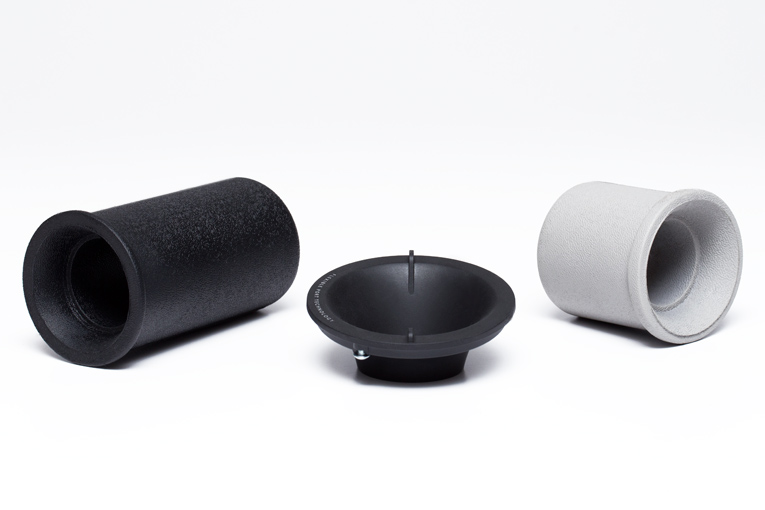
Each Reference 1 comes with two port tubes, a long and a short. These are vital for what they do for the speaker’s bass performance: its depth, and what Oclee-Brown calls its “character,” depend on which tube is installed. This is done by twisting and removing a round, plastic cover on the rear panel, sliding in the tube, and replacing the cover. The long tube is dark gray, about 4.75” long, and results, Oclee-Brown says, in a more gradual rolloff and extension down to 37Hz. The short tube is light gray, about 2.75” long, and produces a rolloff that begins a little lower in frequency, but when the attenuation kicks in its slope is much steeper: the Ref 1’s low-frequency limit is now 40Hz. Both tubes are made of firm but spongy foam and are part of what KEF calls its Flexible Port Technology, which first appeared in the LS50, and which is claimed to reduce port resonances; i.e., noise.
Also on the rear panel are three pairs of large, gorgeous-looking platinum-plated knobs, shaped to be easy to grip and tighten down hard. The top and bottom pairs are, respectively, the connectors for the tweeter and midrange and for the woofer. Between them are identical-looking connectors, labeled Link; turned fully to the right, these join the upper and lower posts internally for single-wiring (i.e., one amplifier, and one pair of cables per speaker), which is how I used the KEFs. Turning the Link posts to the left separates each binding-post pair, to permit biwiring or biamping. I found this system far more elegant and attractive than the jumper wires found with most sets of dual posts.
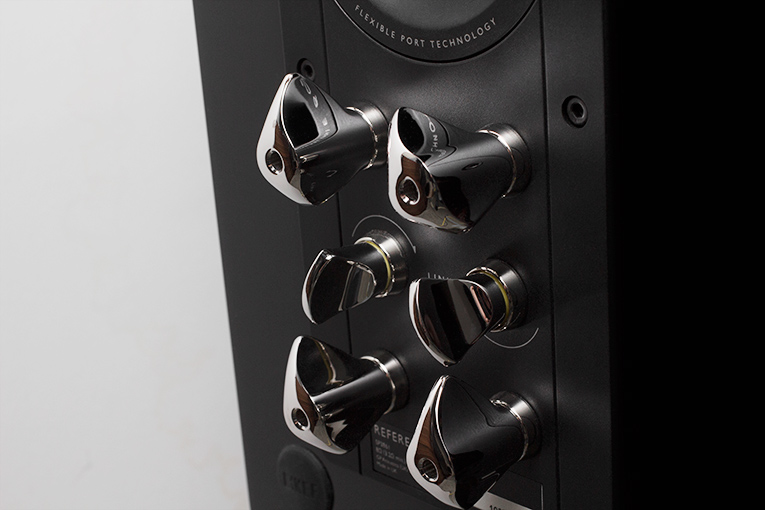
Of the specifications KEF claims for the Reference 1, the sensitivity of 85dB/2.83V/m is a bit on the low side; you’ll need an amplifier that can deliver an appreciable number of watts. KEF recommends 50-200W into 8 ohms, which seems right. The impedance is 8 ohms, dipping to a low of 3.2 ohms, which shouldn’t be too demanding a load for a well-designed amp -- though you probably want to shy away from low-powered tube jobs.
Setup
KEF sells dedicated, 22”-high stands for the Reference 1 ($1499.99), but they weren’t available in North America in time for this review. Instead, I used my 24”-high Foundation stands, which worked well. I drove the Reference 1s with a Hegel Music Systems H30 power amplifier, claimed to output some 350Wpc into 8 ohms -- more than enough. Up front were Simaudio’s Moon Evolution 650D DAC and 740P preamplifier, both connected to Simaudio’s 820S external power supply, as well as a Samsung laptop computer running JRiver Media Center 18. Interconnects were Crystal Cable CrystalConnect Standard Diamond, speaker cables were Siltech Classic Anniversary 330L, and the USB cable was an AudioQuest USB Carbon.
Sound
With the Reference 1s’ long port tubes installed, and listening at low to medium volume levels in my very large room, I heard a sound from the KEF minimonitors that was not unlike what I’d heard from Revel’s four-driver, three-way Performa3 F206 floorstanders ($3500/pair), which I reviewed in September and absolutely loved: superbly clean, extended highs; tight bass reaching down to just above 40Hz; midrange smoothness and clarity to die for; across-the-board neutrality; and superior coherence of the three drivers’ outputs throughout the audioband, with no audible indication of where the woofer’s duties ended and the midrange’s began, or when the midrange handed off to the tweeter. I was paying particular attention to that coherence -- a couple years ago, when I reviewed KEF’s three-way, floorstanding R500 ($2599.98/pair), I found it excellent overall, but had one strong criticism: the R500’s bass, though full, didn’t blend as seamlessly with its midrange as I would have liked. But the outputs of the Reference 1’s three drivers coalesced as one, with ultratight bass.
With the Ref 1s’ short tubes installed, I heard a subtle but definite difference in the bass, but no difference in the mids or highs or in the drivers’ coherence -- all as expected. The prominent kick drum in “A Street,” from Leonard Cohen’s latest studio album, Popular Problems (16-bit/44.1kHz WAV, Columbia), had really good kick indeed, which I liked, but it was slightly lacking in weight compared to when the long port tubes were installed. “Almost Like the Blues,” from the same album, doesn’t have the punch of “A Street,” but it has plenty of weight; here, again, the long tubes proved a better match for my room -- there was more heft overall. These were the results with almost every recording I played.
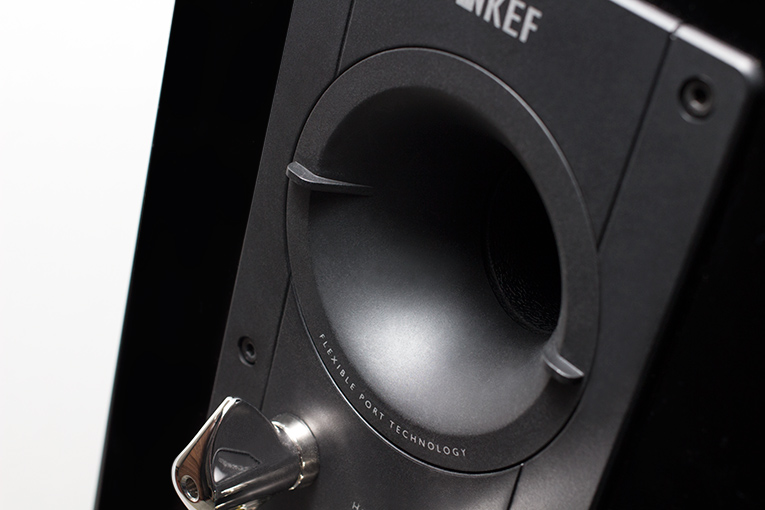
Which port tubes you’ll prefer will depend mostly on the size of your room and where you place the Ref 1s in it. In my very big room, the long tubes were definitely better, nicely fleshing out the bass. But in a much smaller room, or when the Ref 1s are placed close to a wall, both situations in which bass overload can be a problem, the short tubes might be better. Having decided that I’d be using the longer tubes, I settled in for some listening.
I could tell that while the Reference 1 and Performa3 F206 were cut from the same sonic cloth, the KEF could do some things in clearly superior ways. For example, even though the F206 displayed top-drawer clarity and definition throughout the audioband, particularly in the midrange (nothing short of amazing for the price, really), the Ref 1 sounded slightly cleaner, and was capable of even greater resolution overall -- so high that I’d be comfortable pitting the Reference 1 against any speaker of any price or size. Magico’s S5 ($29,400), Polymer Audio Research’s MKS ($42,000/pair), and Sonus Faber’s Olympica III ($13,500/pair), all of which I’ve reviewed in the last year or so, all went deeper in the bass, but revealed no more detail in recordings from the midbass up than did the Reference 1.
Of course, such detailed reproduction also throws a spotlight on any warts in a recording. The light buzz throughout “Samson in New Orleans,” from Popular Problems, was something I’d heard before, but it was so pronounced through the Ref 1s that the first time I listened to this track with the KEFs, I leapt up to check my amplifier, and then my source components -- I was sure something was wrong with my electronics. I suspect that if Cohen’s engineers had monitored this album through a pair of Reference 1s while recording it, that buzz would have been dealt with.
On the other hand, the Reference 1’s spotlighting of engineering flaws never made listening to those recordings objectionable. Hearing that buzz at first caused me concern, but once I’d determined that it was a problem in the recording itself, not its playback, I sat back and listened -- now it was something that was simply there. When I played Damien Rice’s latest, My Favourite Faded Fantasy (16/44.1 FLAC, Atlantic), I was presented with a sound that definitely teetered toward brightness -- that’s how this recording sounds. But it wasn’t off-putting, likely because the speakers were simply revealing what was there, and not exacerbating it by adding distortions of their own.
Also significant were the Reference 1s’ soundstaging and imaging capabilities: outstanding width, tremendous depth, and, most notably, superb precision within the stage. I attribute all of this to the excellent coherence of the drivers’ outputs, the exceptional resolution, and, of course, that Uni-Q coincident driver, which delivers the mids and highs from a single position. Recordings with a properly captured soundstage -- usually, musicians recorded in a real acoustic space with minimal miking; pretty much anything from 2L or Chesky Records -- were well presented, but just as impressive to me was how well the KEFs could dissect recordings whose ersatz soundstages had been assembled on a mixing board from multiple tracks. Of these, I was most impressed by Popular Problems, if only for how vividly the Ref 1s positioned Cohen’s voice center stage, completely and utterly distinct from the other musicians around him -- as if his voice were a distinct entity in space. It was uncanny. The Olympica IIIs, too, sounded detailed, but didn’t dig quite that deep into the recording.
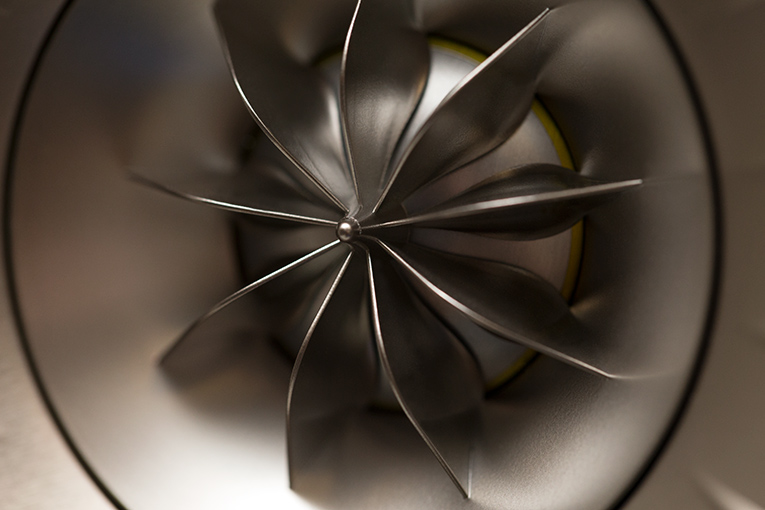
Daniel Lanois’s Acadie, originally released in 1989, was reissued in 2008 in a Goldtop Edition (16/44.1 FLAC, Red Top), with additional tracks. Lanois basically assembled the original Acadie by blending new music with snippets he’d recorded while producing records for other artists. In “The Maker,” drums originally recorded for a Neville Brothers album are placed toward the right and way back in the stage, which the Reference 1s sharply outlined as well as any speakers I’ve heard. The other instruments in this recording fleshed out the stage, utterly distinct in terms of size and space, with Lanois’s voice dead center, positioned as solidly and tangibly as I’ve heard. For presenting a realistic, highly defined soundstage, the Ref 1s have few peers.
Then there was the Reference 1s’ ability to play astoundingly loud -- far louder than the Revel Performa3 F206es could ever hope to -- or any stand-mounted speakers I’ve had here. I also felt that, when I wanted to get out of hand and push things unreasonably hard, given the Ref 1s’ ease in doing so, they could probably play louder in my room than could even the Sonus Faber Olympica IIIs, Polymer Audio Research MKSes, or Magico S5s. But that’s just a guess; I didn’t push any of those speakers quite this hard, for fear of breaking something. This quality was particularly valuable with hard rock -- “You Shook Me All Night Long,” from AC/DC’s Back in Black (16/44.1 FLAC, Atlantic), sounded exceptionally clean -- and electronic music, such as “Contact,” from Daft Punk’s Random Access Memories (24/88.2 FLAC, Édition Studio Masters), which begs to be played at ultra-high SPLs, yet can damage speakers when it is. Suffice it to say that the Reference 1s held together insanely well through all 6 minutes and 21 seconds of “Contact” -- better, in that way, than any speaker I’ve had in here lately.
Surprisingly, the Reference 1s’ ability to play crazy loud while remaining completely in control was also valuable with simpler, sparer music, such as Adam Cohen’s We Go Home (16/44.1 FLAC, Rezolute Music). This outstanding new album -- my favorite of 2014 -- is more folky than pop or rock. It’s essentially Cohen, his guitar, some backing vocals, a piano, drums, and a small string section. I ended up playing the entire album through the Reference 1s, and at higher overall volumes in my room than Cohen himself used when I saw him in concert in a small theater last November. Who says you can’t get lifelike levels at home? Most important, even at these extreme levels -- louder than any sane person would regularly play this music at home -- the sound wasn’t brash or aggressive, as it is with most speakers; instead, it was very clean, and never short of entirely composed. I’ve heard the Vivid Audio Giya G2s play at extreme volume levels and remain in complete control, but those are very large, very expensive ($50,000/pair) speakers. To hear a modestly sized and priced stand-mount approach such extremes was as ear-opening as it was ear-threatening.
Considerations
I’ve heaped high praise on KEF’s Reference 1, but a few things could be problems. The first has to do with the fact that the Ref 1s are stand-mount speakers. No one will put them on shelves (they’re too big and heavy) or sit them on the floor (they won’t sound good). So the full purchase price really must include good-quality stands. Springing for KEF’s dedicated stands will bring the Ref 1’s price to $8999.98/pair.
The next thing to consider is that the Reference 1 is hyperaccurate and superdetailed -- it’s very revealing of all components and cables upstream of it. Don’t partner them with inferior-sounding electronics or cables; instead, use them with something good. But regardless, they’ll point out which is your system’s weakest link.
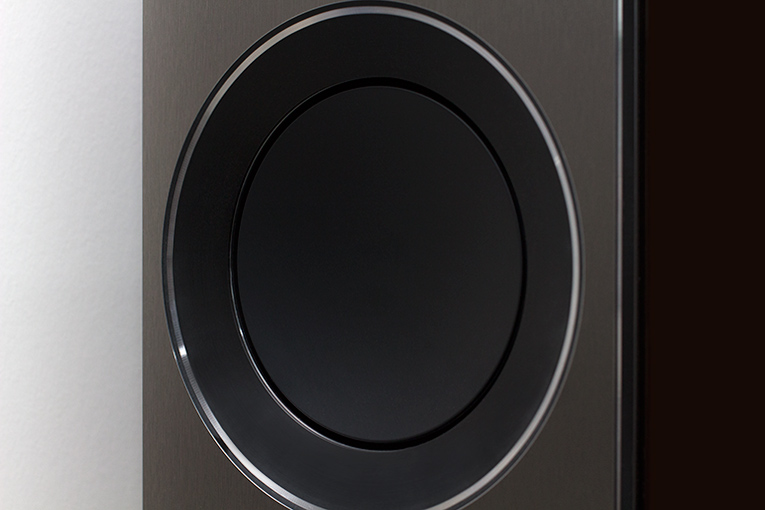
Finally, the Reference 1’s bass: In my very large room, and with the speakers’ long port tubes installed, the bass was deep, powerful, and tight down to at least 40Hz -- outstanding for a stand-mounted speaker. But that the bottom octave of the audioband was basically lopped off shouldn’t be a surprise -- no matter how much clever engineering you throw at it, you just can’t get full-range bass from a 6.5” woofer and a cabinet of this size. If you want deeper bass, you’ll have to partner the Ref 1s with a subwoofer or move up to the larger, floorstanding, multi-woofered Reference 3 or 5.
But if you can live without that bottom octave, or don’t want it because your room is small, or some other reason, rejoice in the fact that, from 40Hz up, the Reference 1 is one of the world’s most accurate- and best-sounding loudspeakers. I say this only in case anyone is under the impression that this small gem can do it all. Almost, but not quite.
Conclusions
With the Reference 1, KEF has raised the bar for stand-mounted loudspeakers in several ways. In a flash, my wife picked up on the speaker’s high-tech appearance and attractive styling. The high level of technology applied -- most notably, the current generation of KEF’s Uni-Q coincident driver -- seems nothing short of an engineering marvel. But most important is the Reference 1’s quality of sound -- within its bandwidth, it’s as accurate as it is musically engaging. This is the kind of speaker that you can use in a studio, to assess every microscopic detail of a recording -- and then turn around and use it at home to actually enjoy everything just captured on tape. The balance of sonic qualities that KEF’s designers has attained is spot on. This modestly sized speaker also has the uncanny ability to play at whisper-quiet and shockingly loud levels with effortless composure. Coupled with its bass, tunable with port tubes, the Reference 1 is a versatile transducer that can work well in a wide variety of rooms -- even very large ones such as mine. That’s rare in a stand-mounted design.
KEF’s Reference 1 is the best stand-mounted speaker I’ve ever heard. The bottommost octave excepted, it’s among the very best speakers I’ve heard of any size and price. As its name implies, the Reference 1 can indeed be considered a reference for stand-mounted loudspeaker design.
. . . Doug Schneider
das@soundstagenetwork.com
Associated Equipment
- Speakers -- Revel Performa3 F206, Sonus Faber Olympica III
- Preamplifier -- Simaudio Moon Evolution 740P
- Amplifier -- Hegel Music Systems H30
- Digital-to-analog converter -- Simaudio Moon Evolution 650D
- Power supply -- Simaudio Moon Evolution 820S (for 740P and 650D)
- Computer -- Samsung laptop running Windows 7 and JRiver Media Center 18
- Digital interconnect -- AudioQuest Carbon USB
- Analog interconnects -- Crystal Cable CrystalConnect Standard Diamond
- Speaker cables -- Siltech Classic Anniversary 330L
KEF Reference 1 Loudspeakers
Price: $7499.99 USD per pair.
Warranty: Five years parts and labor.
KEF
Eccleston Road, Tovil
Maidstone, Kent
England ME15 6QP
UK
Phone: +44 (0)1622-672261
Fax: +44 (0)1622-750653
Website: www.kef.com
North America:
GP Acoustics (US) Ltd.
10 Timber Lane
Marlboro, NJ 07746
Phone: (732) 683-2356
Fax: (732) 683-2358
E-mail: sales@kefamerica.com
Website: www.kef.com/us






















